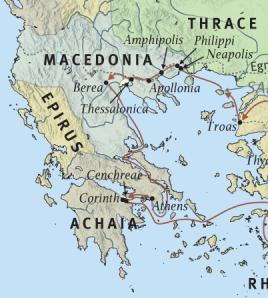1 Thessalonians

Paul and Silas had been at Philippi by the guidance of the Holy Spirit. They had been there for a while when they cast a demon out of the young girl who was fortune telling. They were subsequently beaten and imprisoned. The town officials wanted Paul to go away quietly after discovering he was a Roman citizen. Punishing a Roman citizen without a hearing or judgment against him was illegal. So, they wanted Paul to agree to go away. They let him out of prison and asked him to leave.
After staying with Lydia for a time and encouraging the saints, Paul went on his way. He traveled about 80 miles through Amphipolis and Apollonia, bypassing these cities to visit Thessalonica. Paul and Silas arrived in Thessalonica on Paul’s second Missionary Journey (AD 49-50) (Acts 17:1-9).
Paul's approach was the same as he used in many other cities. He went to the synagogue, where he was allowed to teach. He taught there for three Sabbaths, reasoning with them using the scripture. Paul showed these Jews in the synagogue that Jesus was their long-awaited Messiah. It was a rough start. Some were persuaded, but the Jews who didn’t believe formed a mob and rose in opposition.
The mob couldn't find Paul and Silas, so they dragged some of the other Christians before the rulers of the town. They grabbed Jason. Apparently, that's who Paul and Silas were staying with, and they took him before the town leaders and said, “These who have turned the world upside down have come here too. Jason has harbored them, and these are all acting contrary to the decrees of Caesar, saying there is another king—Jesus.”
Isn't this amazing? We have the testimony of the most devout and religious group of that day, the Jews, testifying that the disciples of Jesus had the reputation as “those who turned the world upside down.” The message of Jesus had been brought to their town by these men who turned the world upside down. But the Thessalonians liked their world the way it was. They didn't need these Jesus freaks messing things up.
Paul left Thessalonica so he wouldn't cause further problems for the believers due to the mob action. We know the names of a few of the new believers he left behind. We know Jason was one of them. Another was a guy by the name of Aristarchus. When Paul came to Thessalonica, Aristarchus heard the gospel and was saved. We don't know anything about the life of Aristarchus before Paul came to town, but we know quite a bit about him afterward. His world was turned upside down when he believed, and his life was changed.
This name, Aristarchus, should sound familiar if you've studied the book of Colossians recently. There, it says that he was in chains with Paul in Rome. His adventure and walk with the Lord started right there in Thessalonica amidst all this chaos. Aristarchus believed, and the believers were immediately hunted down by a mob. Aristarchus may have been nabbed in this riot.
We know that later while traveling with Paul, he got thumped in the riot in Ephesus. And after that, he went on the ship with Paul to Rome and was shipwrecked. And, of course, he ended up in prison with him in Rome. Aristarchus may well have made himself a slave to Paul so he could remain with him throughout his travels.
After shaking things up in Thessalonica by bringing the gospel message, we know Paul left there and went on to Berea. We don't know whether Aristarchus was with him at that point. After a few stops, Paul ended up in Corinth. In the meantime, Timothy had gone back to Thessalonica. When Timothy and Silas returned to Paul in Corinth, they brought news of their travels. Timothy told Paul all about the Thessalonian Christians.
Timothy gave a good report on what was going on there. Paul wrote to encourage the church and answer some of their questions. We'll see a wide array of topics addressed in the five chapters of this book. These were Christians, young in their faith, yet living in a time of persecution. And any time the elect of God seek Him, there will be tests and trials. All these serve to build us up on our faith, but they also generate concerns and questions. Satan is quick to use these concerns and questions to try to cast doubts and strike fear in the hearts of believers. Paul is going to teach them and us in this letter in an effort to calm fears and build faith while answering questions and quieting the concerns of the believers.
Where
Thessalonica was the capital of Macedonia. This city existed for over 4000 years under numerous names. In 315 BC, King Cassander of Macedonia founded the city and named it after his wife, Thessalonica. Thessalonica was the half-sister of Alexander the Great.
This city was on a main east-west highway called the Via Egnatia. This made it a hub of political and commercial activity. It was connected to the world in many ways. And with all these connections, it was a melting pot of spirituality.
Thessalonica was the largest city in Macedonia and had a population of 200,000. It made a perfect place for a new church because, as a cultural hub with tentacles reaching throughout the world, it was a great place to spread the gospel. With the fame of Thessalonica and its importance, it became known as the Mother of Macedonia.
In Paul's day in 51 AD, it had the status of a "free city," which means it was ruled by its own citizens instead of a Roman politician. So, this city and its leaders were not seen as a threat to Rome. That's the setting of the story and some of the history of Thessalonica.
Their Conversion
Encouraged by Timothy
Prayer for the church
Orderly life
Comfort in Christ's coming
